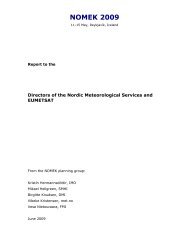International Symposium on Mitigative Measures against Snow ...
International Symposium on Mitigative Measures against Snow ...
International Symposium on Mitigative Measures against Snow ...
You also want an ePaper? Increase the reach of your titles
YUMPU automatically turns print PDFs into web optimized ePapers that Google loves.
<str<strong>on</strong>g>Internati<strong>on</strong>al</str<strong>on</strong>g> <str<strong>on</strong>g>Symposium</str<strong>on</strong>g> <strong>on</strong> <strong>Mitigative</strong> <strong>Measures</strong> <strong>against</strong> <strong>Snow</strong> Avalanches<br />
Egilsstaðir, Iceland, March 11–14, 2008<br />
The design of avalanche protecti<strong>on</strong> dams.<br />
Recent practical and theoretical developments<br />
Tómas Jóhanness<strong>on</strong> 1 *, Peter Gauer 2 , Karstein Lied 2 , Massimiliano Barbolini 3 , Ulrik Domaas 2 ,<br />
Thierry Faug 4 , Kristín Martha Hák<strong>on</strong>ardóttir 5 , Carl. B. Harbitz 2 , Dieter Issler 2 , Florence<br />
Naaim 4 , Mohamed Naaim 4 and Lambert Rammer 6<br />
1 Icelandic Meteorological Office, Bústaðavegi 9, IS-150 Reykjavík, ICELAND<br />
2 Norwegian Geotechnical Institute, PO Box 3930 Ullevål Stadi<strong>on</strong>, N-0806 Oslo, NORWAY<br />
3 FLOW-ING s.r.l. Ingegneria per l'ambiente, P.za J.F. Kennedy 27, I-19124, La Spezia, ITALY<br />
4 Cemagref, Divisi<strong>on</strong> Erosi<strong>on</strong> torrentielle, neige et avalanches, BP 76, F-38402 Saint Martin d’He`res, FRANCE<br />
5 VST C<strong>on</strong>sulting Engineers Ltd., Ármúli 4, IS-104 Reykjavík, ICELAND<br />
6 Department of Natural Hazards and Alpine Timberline, Federal Research Centre for Forests, Natural Hazards<br />
and Landscape, BFW, Rennweg 1, A-6020 Innsbruck, AUSTRIA<br />
*Corresp<strong>on</strong>ding author, e-mail: tj (at) vedur.is<br />
ABSTRACT<br />
Recent experimental and theoretical studies of the flow of avalanches <strong>against</strong> obstructi<strong>on</strong>s<br />
have been used, in combinati<strong>on</strong> with traditi<strong>on</strong>al design guidelines, to formulate recommendati<strong>on</strong>s<br />
for the design of dams and other protecti<strong>on</strong> measures in the run-out z<strong>on</strong>es of wet- and<br />
dry-snow avalanches. These recommendati<strong>on</strong>s deal with the design height of dams, geometry<br />
and layout of braking mounds and impact forces <strong>on</strong> walls and other obstacles. In additi<strong>on</strong>,<br />
laws and regulati<strong>on</strong>s regarding hazard z<strong>on</strong>ing below avalanche protecti<strong>on</strong> measures in different<br />
European countries are described. The main new features of this procedure to dimensi<strong>on</strong><br />
dams are:<br />
• The dam design is based <strong>on</strong> a c<strong>on</strong>sistent dynamic descripti<strong>on</strong> of the interacti<strong>on</strong> of<br />
shallow granular flow and an obstructi<strong>on</strong>.<br />
• Shock dynamics are used to derive run-up heights <strong>on</strong> dams, which determine the<br />
design dam height under some c<strong>on</strong>diti<strong>on</strong>s.<br />
• The necessary dam height to prevent supercritical overflow is also used to derive runup<br />
heights <strong>on</strong> dams, which determines the design-dam height under other c<strong>on</strong>diti<strong>on</strong>s.<br />
• A maximum allowable deflecting angle, derived from shock dynamics, limits the<br />
range of possible deflecting angles of deflecting dams.<br />
• Momentum loss in the impact with a dam is calculated from the comp<strong>on</strong>ent of the<br />
velocity normal to the dam in the same way for both catching and deflecting dams.<br />
• Avalanche flow al<strong>on</strong>g deflecting dams becomes canalised, which may lead to a<br />
substantial increase in run-out in the directi<strong>on</strong> of the canalised flow.<br />
• A c<strong>on</strong>sistent dynamic framework makes it possible to account for the slope of the<br />
terrain where a dam is located and a curvature of the dam axis in the dam design.<br />
1. INTRODUCTION<br />
Dams in the run-out areas of snow avalanches are widely used as protecti<strong>on</strong> measure <strong>against</strong> wet-<br />
and dry-snow avalanches (Figure 1). Several methods have been used to design avalanche dams,<br />
based either <strong>on</strong> simple point mass c<strong>on</strong>siderati<strong>on</strong>s, widely used in Alpine countries, a descripti<strong>on</strong><br />
of the dynamics of the leading edge of the avalanche or <strong>on</strong> numerical computati<strong>on</strong>s of the<br />
200 The design of avalanche protecti<strong>on</strong> dams











